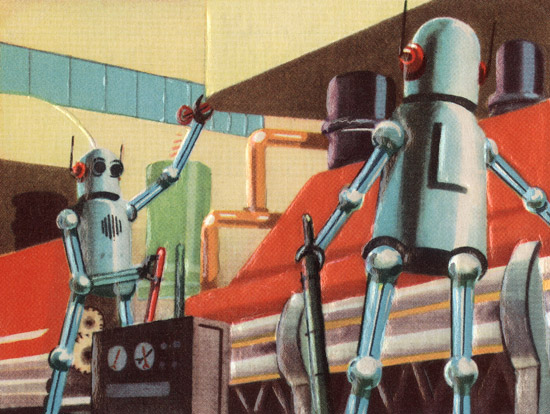

Art from the 1950s envisioned a future with robots. Are we there yet? Credit: Blue Lantern Studio / Corbis
I first encountered the future during a family trip to Disney World’s EPCOT Center in the early 1990s. Walt Disney had envisioned EPCOT (the Experimental Prototype Community of Tomorrow) as a utopian, enclosed city that would be erected in central Florida. That vision never came to pass. Instead, in 1982, EPCOT opened as a theme park—a sort of permanent World’s Fair—showcasing the technological promises of tomorrow. Yet, in the span of a decade, EPCOT had already begun showing its age. Even as a kid, I remember thinking that the silver jumpsuit future that EPCOT was selling didn’t feel like the 1990s; it was the future as imagined in the 1980s.
People are drawn to futurism for the wondrous spectacle of it all. Yet, those captivating images of personal jetpacks and flying cars also offer a window into history that is unlike any other. Past visions of the future reflect American hopes and fears in a fantastical way, and thus do so with unique honesty.
During World War II, for instance, the American public clung to the promise that the sweet material rewards of their sacrifice were just around the corner. A 1944 poem from Dorothy Roe, the women’s editor of the Associated Press, distilled the sentiment quite succinctly:
After the war . . .
We’ll just a press a button for food or for drink,
For washing the dishes or cleaning the sink.
We’ll ride in a rocket instead of a car.
And life will be streamlined . . .
After the war.
I’ve spent the last five years researching and blogging about what is popularly known as “retro-futurism.” In doing so, I’ve assembled an enormous private collection of material culled from used bookstores, eBay, Amazon and generous individuals who have donated their own relics. My archive begins in the late 19th century—with books like Edward Bellamy’s classic utopian novel Looking Backward—and covers every decade of the 20th century.
If there’s one vision of the future I’ve never encountered, it’s the status quo. Futurism, for most people, is about the best and the worst that will befall us. Sure, some individuals may romanticize history and cry out that society must return to some idealized version of the past that may never actually have existed, but very few people imagine tomorrow as being exactly like today.
I’m tremendously excited about Paleofuture’s new home at Smithsonian magazine, and I look forward to you joining me in my continuing exploration of the futures that never were.